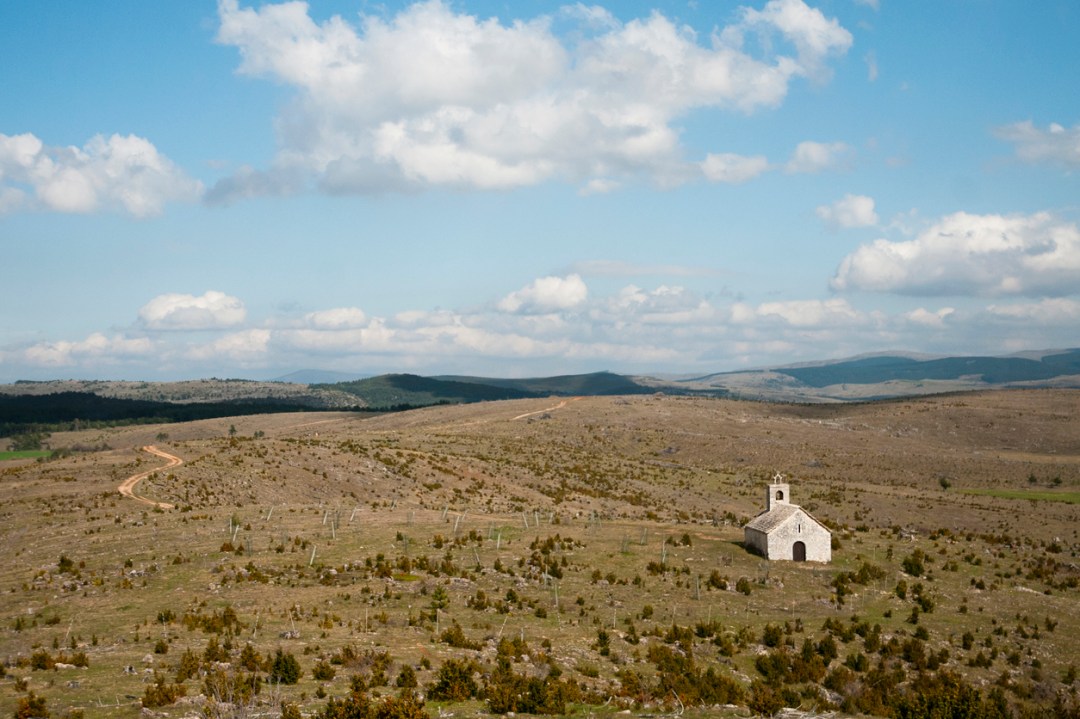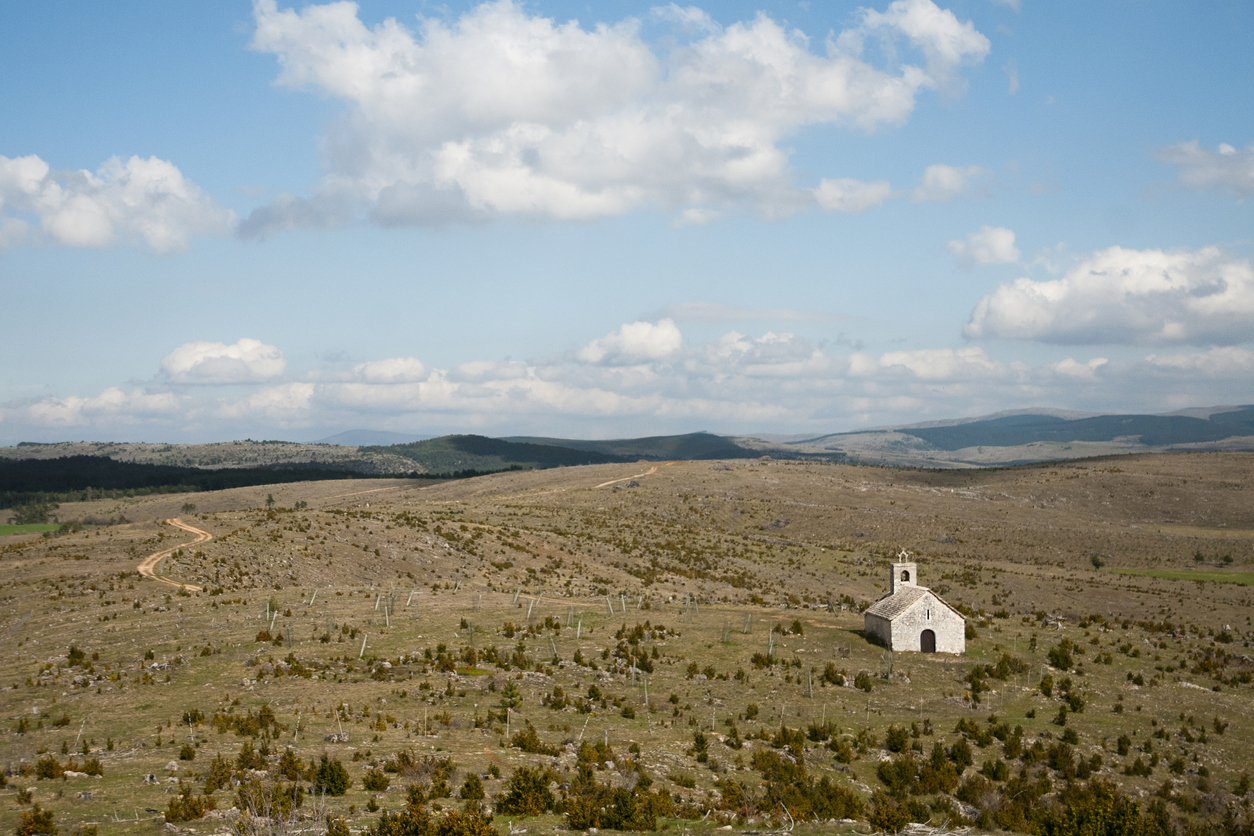As a travel writer, you soon learn that there are countries which, when you mention them, elicit a polite smile of incomprehension, which says: er, where’s that then? Laos is a classic example. Also Kyrgyzstan. And maybe Eswatini.
But can it be true that there are chunks, regions, entire departments of France that conjure the same puzzled stare? Oui, my Spectator reading friends, c’est vrai: and that place is Lozere. France may be the single most touristed country on earth, the one country the whole world knows, yet for the last few weeks, when I’ve told people I’m off to do a French travel piece in the department of Lozere I’ve been confronted with flat incomprehension, then embarrassingly incorrect guesses: is it in Brittany? Is it an overseas island?
In the 18th century, Lozere was plagued by La Bete de Gevaudan, a legendary monster which, unlike most legendary monsters, is brilliantly based on reality
And now, as I sit here nibbling chunky, tasty, knobbly local charcuterie, in the slant September sun, in the pretty, stone-built, shaded-by-a-plane-tree terrace of the Hotel Restaurant La Route d’Argent, in quaint little Nasbinals, Lozere, next to the lyrically medieval church – famous as the grave of a local bonesetter, which is itself somehow fantastically, parochially Lozerienne – I can feel a proper sense of superiority. I have come somewhere in France that no one else knows about, including plenty of French people – even if it is, itself, so authentically French you can’t move for old men sitting at zinc-topped bars, passive-aggressively shrugging under their berets as they sip glasses of pastis and think about nougat.
One reason for Lozere’s anonymity is its glorious emptiness: per square kilometre, it is the emptiest department in the country. Another, perhaps, is Lozere’s hard-to-categorise geography. It is technically a part of the Occitanie region, and barely 100 klicks from the Med – therefore surely in the burning south, the Midi! And yet its tough, exhilarating and rugged high-country landscapes – moorland, woodland, cataracts, mountains – somehow make it a determined, reclusive outlier of the north.
This landscape is why, what few tourists there are, tend to be hikers (or motorbikers, who adore the gloriously deserted roads). This in turn explains why the locals are now insisting I try the stomach-filling local delicacy, a special mashed potato, aligot, stirred with rich Tomme de Savoie cheese – which is being served from a communal metal pot like the potion in Asterix books. Aligot is expressly designed for people who have walked across peaks and burned a trillion calories (as Robert Louis Stevenson did, famously, with a donkey, in the Cevennes, described in his slyly entitled book Travels with a Donkey in the Cevennes). Make sure you bring an appetite.
Next morning dawns bright, sharp, sunny, and somehow northern-yet-southern, and I drive my overfed self across the pale brown plateau moors of Aubrac (revered for its magnificent beef cows) to remote, wind-combed, mystical Saint Andeol lake. This could be a whispering corner of upland Cumbria or Yorkshire, if it weren’t for the beautiful French actress and the French TV crew on the lakeshore. They are, they tell me, filming a witchcraft drama; the eerily desolations say: good choice.
Next stop, Le Malzieu-Ville (if you want an authentic yet budget lunch here, try Chez Pierrot in the main square). This has just been named one of ‘France’s prettiest villages’ by France, and France has a point. The fortified medieval centre has its bashfully cute lanes, Grimm’s fairytale archways and strangely ornate stone portals speak of ancient money, which helps to explain the mystery of ‘Empty Lozere’.
In the past Lozere got rich from looming fine Cevenol silk (all those gushing waterfalls are great for watermills), urbane Italians shifted here to build their impressive townhouses on the profits, then came brutal religious wars, followed by deindustrialisation: and with it the disappearance of half Lozere’s population, which has never truly returned.
The werewolf didn’t help, either. In the 18th century, Lozere was plagued by La Bete de Gevaudan, a legendary monster which, unlike most legendary monsters, is brilliantly based on reality. There really was a mysterious beast, it definitely killed a lot of people, it got so bad the French King offered a bounty. Then something got shot and the killing stopped but the cadaver of the thing conveniently decomposed. What was it? Just a massive bad-tempered wolf? A very big madman in a convincing costume?
You can learn all about La Bete and much else in the excellent new local museum in Lozere’s tiny ‘capital’ – Mende, which must be one of the most adorably ignored cities in the country. Mende’s medieval cathedral, with its Gallo-Roman origins, is an intriguingly beaten-up old thing (scene of a horrible massacre in those religious wars), meanwhile the best hotel is, of course, called the Hotel de France (think pretty old coaching inn with nice prix fixe menus); at night the unpretentious open-air bars can’t decide whether to drink southern rose or northern lager, so they mainly do gin and tonic and croque monsieur.
There is much more to see in Lozere – storied, pretty, stone-built, water-falling towns like Florac, St Enemie, Pont de Montvert, or famous caves, cliffs, causes, and craft distillers and wineries, but time limits me to just two more destinations.
The first is the Cham des Bondons, which might be the least known of Europe’s great megalith-scapes. No one is quite sure how many standing stones there are (more are re-erected every year, adding to the confusion), but there are certainly enough to be nobly impressive. The silent menhirs generally stand on lofty hill-crests, gazing south across the green woods, slopes and chasms, which melt away to the distant Med. They seem to be guarding something important, or maybe carefully watching out – but what exactly it is they guard or fear, no one knows.
Final stop: one of those chasms, the mighty and grandiose Gorges du Tarn. Here you can go kayaking, rafting, climbing, canoeing, anything. Me, I get a decorous and traditional batelier boat trip down the echoey, sun-lanced limestone canyon, watching out for vultures, beavers, otters, dippers, and kingfishers – one of the advantages of Lozere’s emptiness is abundant wildlife. Then I repair to the micro-Carcassonne of the towered and fortified hotel Manoir de Montesquieu, which is deliciously located right on the waters. At night the sweet hotel garden turns into a lamplit riverbank restaurant. Here, at the warm, dulcet southern limits of Lozere, I order something from the northern frontier: Aubrac ribeye steak with frites. It is all I want and all I need. Then, as the moonlit night steals across the Lozerienne wilds, I climb to my riverside room and I am hushabyed to sleep by the sound of the tumbling Tarn, dreaming that maybe there are more untouched corners of France, just like this, yet to be discovered.







Comments